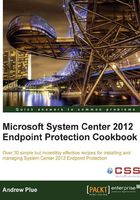
What this book covers
Chapter 1, Getting Started with Client-Side Endpoint Protection Tasks, provides a number of recipes for performing tasks at the local client level, such as forcing a definition update or modifying the SCEP client policy.
Chapter 2, Planning and Rolling Installation, will walk you through some of the considerations you will need to make before deploying SCEP, as well as showing you how to enable the SCEP role on your SCCM server.
Chapter 3, SCEP Configuration, will show you recipes for performing essential tasks, such as configuring SCEP policies and alerts, as well as walking you through the process of setting up SCEP's reporting features.
Chapter 4, Client Deployment Preparation and Deployment, includes a number of recipes to assist you with every step of client deployment from preparation to actually deploying the clients.
Chapter 5, Common Tasks, covers a number of day-to-day tasks that every SCEP administrator will need to know how to do it correctly in order to keep SCEP healthy and your Endpoints protected from malware.
Chapter 6, Management Tasks, covers important high level tasks, such as using policy templates, merging polices, and responding to SCEP alerts.
Chapter 7, Reporting, makes a deep dive into the reporting capabilities offered with SCEP. You will be shown how to execute reports, as well as provide access to reports. You will also be shown how to create your own custom reports.
Chapter 8, Troubleshooting, provides you with some tools to assist you with the time-consuming effort of troubleshooting an anti-malware product. The recipes in this chapter will help you deal with Definition Update issues, as well as how to approach false positives.
Chapter 9, Building an SCCM 2012 Lab, is a great chapter for anyone who has not yet taken the plunge on SCCM 2012. There is just a single recipe in the chapter that will show you the quickest down-and-dirty method for standing up an SCCM 2012 server in a lab environment. This is vital to anyone considering deploying SCEP, because with the total integration of SCEP with SCCM 2012, you can't experience SCEP without an SCCM environment.
Appendix, walks you through the installation of the System Center Security Monitoring Pack for Endpoint Protection.